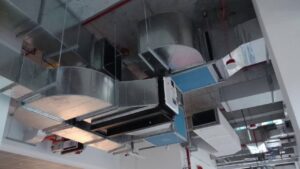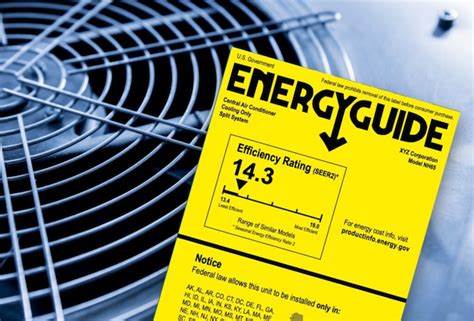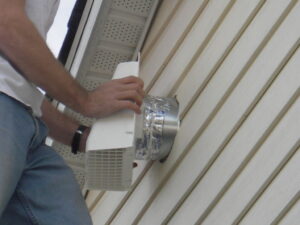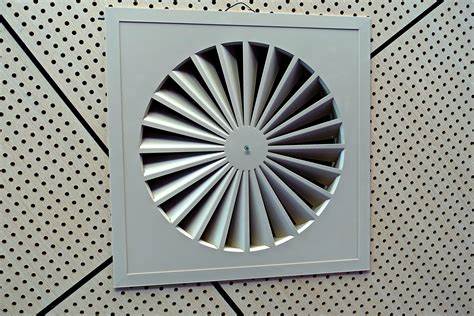Welcome to the world of exhaust ventilation systems, the unsung heroes of indoor air quality! In this comprehensive guide, we’ll dive into everything you need to know about these essential systems that work tirelessly to keep our indoor environments fresh, clean, and healthy. From kitchens to bathrooms and industrial settings, exhaust ventilation systems are pivotal in removing pollutants, controlling humidity, and ensuring a steady flow of fresh air.
Whether you’re curious about how these systems operate, the different types available, or the importance of regular maintenance, you’re in the right place. We’ll also explore their impact on energy consumption and how innovative designs can help minimize it. So, let’s get started on this enlightening journey through the ins and outs of exhaust ventilation systems, and discover how they contribute to making our indoor spaces safer and more comfortable for everyone.
What is an Exhaust Ventilation System?

An exhaust ventilation system is a critical component designed to improve indoor air quality by removing polluted air, excess moisture, odors, and airborne contaminants from a designated space. Central to its operation is the principle of extracting indoor air and expelling it to the outdoors, thereby preventing the accumulation of potentially harmful particles and gases within an enclosed environment. This system typically consists of ducts, fans, and vents strategically placed to facilitate the efficient movement of air from inside to outside.
The primary goal of an exhaust ventilation system is to ensure a healthy living or working environment by maintaining adequate indoor air quality. It accomplishes this by continuously replacing stale, contaminated indoor air with fresh outdoor air. This process not only helps in reducing the concentration of pollutants but also aids in controlling humidity levels, thus mitigating the risk of mold growth and structural damage.
Exhaust ventilation systems are particularly crucial in areas where pollutants are generated at high levels, such as kitchens, bathrooms, and industrial settings. By effectively removing airborne contaminants and excess moisture, these systems play a pivotal role in safeguarding the health of occupants and preserving the integrity of buildings. Through the strategic implementation of exhaust ventilation, spaces can achieve a balance between energy efficiency and optimal air quality, making it an indispensable component in modern architectural design and environmental health management.
Why is Proper Ventilation Important in Buildings?

Proper ventilation is crucial for maintaining healthy indoor environments in buildings. It serves to remove contaminants like smoke and toxic gases, which can be harmful to occupants. By controlling humidity, ventilation systems prevent mold growth, protecting the structure of the building and the health of its inhabitants.
Additionally, reducing indoor pollutants and improving air quality significantly lowers the risk of respiratory problems. This ensures that the air inside buildings is safe to breathe, making proper ventilation a key factor in safeguarding both the well-being of occupants and the integrity of the building itself.
Removes Contaminants Like Smoke and Toxic Gases
Proper ventilation effectively eliminates harmful contaminants such as smoke and toxic gases, ensuring the indoor environment remains safe and clean for occupants.
Controls Humidity to Prevent Mold Growth
By regulating indoor humidity levels, proper ventilation significantly reduces the likelihood of mold growth, safeguarding both the building’s structural integrity and the health of its inhabitants.
Reduces the Risk of Respiratory Problems by Improving Air Quality
Improving air quality through adequate ventilation is key to minimizing the risk of respiratory problems among building occupants, contributing to overall better lung health and well-being.
How Does an Exhaust Ventilation System Work?

An exhaust ventilation system operates by extracting air from inside a building and directing it outside. This process uses mechanical means, such as fans or ducts, to ensure a continuous flow of air. By removing stale, contaminated air and replacing it with fresh outdoor air, the system effectively maintains the quality of the indoor environment, making spaces safer and more comfortable for occupants.
Extracts Air from Inside to Outside Using Mechanical Means
The system efficiently pulls air out of the building through mechanical devices like fans, maintaining a fresh and clean indoor environment.
Uses Fans or Ducts to Direct Airflow
Fans of ducts play a crucial role in guiding the airflow from the interior to the exterior, ensuring optimal air circulation and ventilation.
What are the Types of Exhaust Ventilation Systems?
Exhaust ventilation systems come in various types to suit different spaces and needs. Wall-mounted exhaust fans are ideal for direct ventilation in specific areas like kitchens or bathrooms, targeting localized contaminants. Ceiling-mounted fans offer general air circulation, beneficial for overall room ventilation.
Inline exhaust fans, installed within ducts, provide centralized extraction, efficiently removing air from multiple points to a single exterior outlet. Each type is designed to optimize air quality and ensure a healthy indoor environment.
1. Wall-Mounted Exhaust Fans for Direct Ventilation in Specific Areas
Wall-mounted exhaust fans are specifically designed for targeted ventilation, efficiently removing air and contaminants directly from areas like kitchens and bathrooms.
2. Ceiling-Mounted Fans for General Air Circulation
Ceiling-mounted fans enhance the overall air quality and comfort within a space by facilitating general air circulation, ensuring fresh air is evenly distributed.
3. Inline Exhaust Fans Installed Within Ducts for Centralized Extraction
Inline exhaust fans, integrated into the ductwork, provide a powerful solution for centralized air extraction, effectively channeling air from multiple locations to a single exterior exit.
What Factors Should Be Considered When Installing an Exhaust Ventilation System?

When installing an exhaust ventilation system, several key factors must be considered to ensure optimal performance and efficiency. The size of the area is crucial, as it determines the capacity of the system needed to achieve adequate air exchange. The type of contaminants present influences the choice of air filters and system design to effectively remove pollutants.
Additionally, noise levels are an important consideration to minimize disruption and maintain a comfortable environment. Taking these factors into account ensures the ventilation system is tailored to meet the specific needs of the space, promoting a healthy and safe indoor atmosphere.
Size of the Area to Ensure Adequate Air Exchange
The size of the area directly impacts the selection of an exhaust ventilation system, ensuring it is capable of providing sufficient air exchange to keep the indoor environment healthy and fresh.
Type of Contaminants to Determine Filtration Needs
Understanding the specific types of contaminants present is crucial for determining the necessary filtration requirements, ensuring the system is equipped to effectively purify the air.
Noise Levels to Minimize Disruption
Considering noise levels is essential to reduce disruption, aiming for a system that operates quietly to maintain a serene and comfortable indoor atmosphere.
How Can One Maintain an Exhaust Ventilation System?

Maintaining an exhaust ventilation system is essential for ensuring its efficiency and longevity. Regular cleaning of filters is crucial to prevent clogging and maintain air quality. Checking for duct blockages is necessary to ensure that airflow is unimpeded.
Additionally, ensuring fans are functioning properly is key to consistent operation. These maintenance steps help in preventing common problems and ensure the system continues to provide a healthy indoor environment effectively.
Regular Cleaning of Filters to Maintain Efficiency
Regular cleaning of filters is essential, as it directly impacts the system’s efficiency, ensuring clean air circulation and optimal energy use.
Checking for Duct Blockages to Ensure Unimpeded Airflow
Periodic checking for duct blockages is crucial for maintaining seamless airflow, which is vital for the system’s effectiveness and the comfort of indoor spaces.
Ensuring Fans are Functioning Properly for Consistent Operation
Ensuring that fans are functioning properly is key to achieving a consistent and reliable operation, keeping the environment fresh and well-ventilated at all times.
Also Read: How To Clean HVAC System: A Complete Guide
What are Common Problems with Exhaust Ventilation Systems?

Exhaust ventilation systems, vital for maintaining indoor air quality, can face several common issues. Motor failure is a frequent problem, often due to wear and tear, disrupting the system’s operation. Duct leakage leads to reduced efficiency by allowing conditioned air to escape, affecting the system’s effectiveness.
Additionally, overheating of components from continuous use can impair the system’s functionality and longevity. Promptly addressing these issues is crucial to ensure the ventilation system continues to provide a healthy indoor environment effectively.
Motor Failure Due to Wear and Tear
Motor failure, a result of wear and tear, poses a significant challenge, disrupting the functionality of exhaust ventilation systems and necessitating prompt intervention.
Duct Leakage Leading to Reduced Efficiency
Duct leakage undermines the efficiency of ventilation systems, allowing conditioned air to escape and thus diminishing the system’s effectiveness in maintaining optimal indoor air quality.
Overheating of Components from Continuous Use
Continuous use can lead to overheating of components, a prevalent issue that affects the performance and durability of exhaust ventilation systems, underscoring the importance of regular checks and maintenance.
How Do Exhaust Ventilation Systems Impact Energy Consumption?

Exhaust ventilation systems significantly influence a building’s energy consumption. Their operation, especially the use of fans, can lead to an increase in energy use. However, with proper design and implementation, the impact on energy consumption can be minimized.
Innovations such as energy recovery ventilators offer a way to recapture some of the energy from exhausted air, enhancing the system’s overall efficiency. Thus, while exhaust ventilation systems do consume energy, thoughtful design and advanced technology can mitigate their impact, contributing to more energy-efficient buildings.
Can Increase Energy Use Due to Fan Operation
The operation of fans within exhaust ventilation systems can significantly increase energy consumption, underscoring the need for efficient fan management.
Proper Design Can Minimize Energy Waste
Through proper design, exhaust ventilation systems can be optimized to minimize energy waste, ensuring they operate with maximum energy efficiency.
Energy Recovery Ventilators Can Recapture Some Energy from Exhausted Air
Energy recovery ventilators present an innovative solution, capable of recapturing energy from exhausted air, thereby improving the energy efficiency of the overall system.
Also Read: Rapid Response: Mastering Emergency HVAC Repair When You Need It Most
Enhancing Indoor Air Quality with Effective Ventilation Solutions

Exhaust ventilation systems are essential for maintaining indoor air quality by removing contaminants, controlling humidity, and ensuring a steady supply of fresh air. Various types, including wall-mounted, ceiling-mounted, and inline fans, cater to different ventilation needs. When installing these systems, considerations such as area size, contaminant type, and noise levels are crucial for optimal performance.
Regular maintenance, including cleaning filters and checking for duct blockages, is vital to prevent common issues like motor failure and overheating. While these systems can increase energy consumption, strategic design and technologies like energy recovery ventilators can significantly mitigate their impact, contributing to more energy-efficient buildings. Ultimately, exhaust ventilation systems play a pivotal role in creating healthier, more comfortable indoor environments.
At Callidus Air, we specialize in designing and installing high-quality exhaust ventilation systems tailored to your specific needs. Contact us today to learn how we can help you improve your indoor air quality while maximizing energy efficiency. Let’s create a healthier, more comfortable environment for you and your family.

